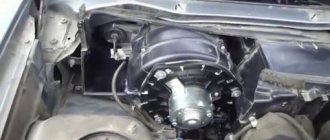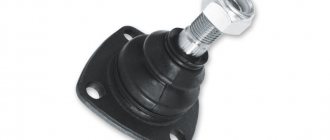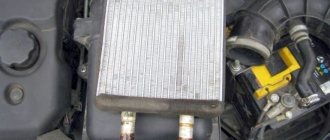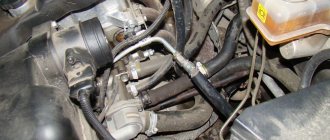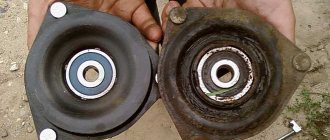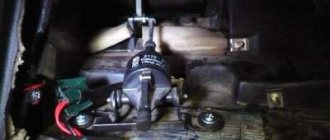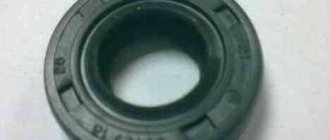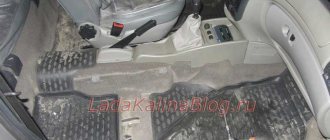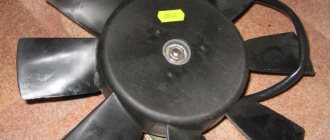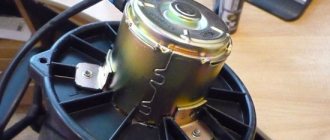In general, about a year ago I bought a new stove fan at the BBC store, aka “avto49”. But it was so crooked and so new that after installing it, the last thing I wanted was to take everything back and go change it. And the defect was that the blades and rim of the fan themselves (which are plastic) were deformed and, accordingly, not centered, because of this strong vibrations occurred during rotation. At 1 (sometimes we were lucky at 2) speeds this did not appear, so we decided not to take it back.
I didn’t like the situation with the fan, I wanted to change it, but I didn’t get around to it before winter. Then the frosts came, I really didn’t want to get into the car (garage without heating =), so I had to suffer and warm up the interior at 1st speed =
Now that it’s warmer, I finally got around to it and below I’ll write a short epic of what happened and how it happened))
I couldn’t find any clear instructions on the Internet without understanding the gender of the muzzle, so I acted “according to circumstances,” i.e. I unscrewed everything that was in the way and tried to get it out)) By the way, a lot of leaves were clogged in the air intake, the stove was not blowing from all the holes, so I also bought a cabin filter and went to change it)
I replaced the stove fan on a Priora with a minimum of disassembly and without draining anything)). By the way, my car is 2007. no air conditioning.
I have a lot of foliage accumulated there. I saw on the drive that they attach a fine mesh to the air intake, but unfortunately I didn’t have one, so I couldn’t implement this idea.
First, as usual, I unscrewed the filter grille
I removed everything else, everything is extremely simple and clear
Removing the heater fan on a Priora is difficult, but possible.
Remove the right side of the engine compartment bulkhead trim. The heater fan motor is visible, but you can’t get to it: the outer plastic casing of the air conditioning unit is in the way and can only be removed by dismantling the entire air conditioning unit assembly (draining the antifreeze, removing the vacuum brake booster, draining freon from the air conditioning system, etc.).
We make a cut on this casing in the indicated place, which will make it possible to remove the right side of the casing and get to the heater fan
The heater motor is in our hands.
We assemble in the reverse order
Removing the heater damper gearmotor
In order to check the functionality and ensure the maintainability of the micromotor gearbox, it will have to be dismantled. There is nothing complicated in this process, but you need to know and follow the sequence of actions. You will learn how to remove the heater gear motor on a Priora from the guide below:
First you need to remove the windshield wipers. After this, the frill must be dismantled, which any car owner can handle - to do this, you need to unscrew the fastening screws located in the upper part of the protective element under the plugs and at the bottom on the casing
Don't forget also about the screw connecting the edges of the two skins. After removing the frill, pay attention to the antifreeze tank, which is located next to the vacuum brake booster - you need to disconnect the outer pipe from it and pull it through the hole in the casing. Next, remove the antifreeze tank from its seat to gain access to the casing. The casing itself, or rather, its left part, should also be removed, and as for the second part, its dismantling is not necessary. The fastening of the antifreeze tank must also be removed (attached with two bolts and one nut), since it will interfere with the process of dismantling the gearmotor
You will also have to remove the rods and the wiper drive motor. After this, access to the heater damper gearmotor opens, which is removed by unscrewing three mounting bolts.
After removal, the device is disconnected from the power supply and is subject to diagnostics for repairability. If it turns out that restoration of functionality is possible, appropriate repair work is carried out. Otherwise, the only solution is to replace the gear motor of the Priora stove. But first, let's look at the troubleshooting process.
How to change the heater radiator on a Lada Priora
In fact, every motorist who owns a Russian vehicle discovers a malfunction of the car’s heating unit specifically in winter. After all, only with the advent of severe cold does a person begin to think about how to avoid freezing while driving a car. Naturally, everyone uses a stove for this. But what should those for whom this same device does not work properly do? After all, only the heater is able to ensure that the normal temperature is maintained in the cabin, allowing for comfortable movement. In this article we will look at only one reason why the heating device stops working, we will learn about the principles of repairing and replacing the heater radiator installed in a Lada Priora car.
If the motorist is sure that the heater core needs to be replaced, it may take a lot of time to remove the faulty object, because most likely, in the process it will be necessary to change not just a blown fuse, but to carry out more serious repair work. True, one should not immediately despair because of one’s own ignorance; the material contains a carefully written annotation that helps everyone understand how to replace the stove radiator in a Priora with and without air conditioning.
Replacing the radiator of a heating unit in a Priora that is not equipped with air conditioning
Replacing the heater radiator on a Priora without air conditioning may make sense in this case if warm air does not begin to flow into the cabin, while the heater itself is working. If, in addition to the above dilemma, there is also a water leak from under the Priora stove, the motorist will have to urgently remove the poorly functioning unit in order to solder the latter. From time to time, repairs are impractical and you have to replace the old device with a new one.
So, first, you need to start by removing the negative terminal from the battery. The fact is that the issue here is not only about the safety of the master himself, but also about additional insurance, which allows him to avoid several nasty surprises that, if handled carelessly, can appear not only with wiring, but also with electrical equipment.
If you are replacing the heater radiator on a Priora without air conditioning, after de-energizing the system, you can begin to dismantle the windshield trim. At the same time, you should also remove the wiper arms, which can cause further discomfort during operation. After that, you should free the unit from all plastic tubes, through which the liquid located in the windshield washer reservoir goes directly to the nozzles. Only after all the above steps have been carried out will it be possible to remove the decorative trim located on the sides of the windshield. In fact, performing such a manipulation is simple - just get rid of 7 screws.
Replacing the heater radiator on a Priora can only be done after removing the hood seal. Before dismantling, it should be taken into account that there is a screw in the middle of the lining that tightens both halves of the structure. Using a screwdriver or any knife, you can carefully lift the plugs (this element serves as the “cover” of the screw) and unscrew them.
After which you can begin to remove the sound insulation, which is located in the unit compartment. To do everything well, you will have to unscrew the screws and remove the pads (there is no clear rule about which of them to remove first: left or right). Then you should get rid of the pipes that go directly to the radiator. A person who wants to figure out how to get to the heater radiator on a Priora must loosen the clamps holding the structure itself.
After which you can remove from the connectors all the wires going specifically to the stove. You can remove them using two keys, namely, the first “10”, and the other “8”. After unscrewing all four nuts, move the wiring harness to the side, which is held in place by the holder. The “13” key will help to dismantle the bracket located on the brake pedal. Only then can you begin to remove the heater radiator on a Priora that does not have air conditioning. An ordinary Phillips screwdriver will help to dismantle the device, allowing you to remove 3 screws. All the rest of the work consists of installing a new unit and reassembling the system in the reverse order of the described actions.
Changing the cabin filter
There are Lada Priora configurations that include air conditioning. It could be HALLA or Panasonic. Owners of such cars are also concerned about replacing the stove on a Priora with air conditioning. But first, it’s worth understanding the air conditioners themselves, which differ not only in the country of manufacture.
HALLA is made in Korea and Panasonic is made in Taiwan. You can find out which air conditioner is installed in your car by visual inspection.
Attention should be paid to the button, which is located in the center of the air conditioner control panel. Panasonic system has a button to turn on, but HALLA does not have such a button
Car owners should regularly change the filter to ensure that the cabin is free of foreign odors from the street and the air is clean. Before you find out how to change the heater filter on a Priora, you need to know the type of system that is installed in your vehicle. After all, each cooling system model has different filter elements.
The filter changes differently depending on whether the car has air conditioning or not. If the car is not equipped with an air conditioning mechanism, then proceed as follows:
- Open the hood.
- We dismantle the grill installed under the glass on the left. There are screws on it, closed with plugs. They need to be unscrewed. After completing this step, access to the filter will be freed.
- The cleaning component cover is held in place by four bolts that must be removed.
- We remove the cover, which will allow us to get the filter. We clean the vacated area from possible contamination and debris.
- We install a new filter element and assemble the car in the reverse order.
If the car has a cooling mechanism, the actions will be slightly different.
- Open the hood and find the required part.
- We bend the upholstery material.
- If Panasonic is installed, then the latch on the filter element must be unscrewed. With a Hull cooler, you will need to press the latch, which will open the lid.
- We take out a filter that has already served its purpose and in its place we put a new one, which will need to be twisted using the slots in the housing.
- We install the cover and all parts in their place.
Repairing the Priora stove may be associated with a number of problems that initially need to be correctly diagnosed. We will write several more articles on this topic and consider the main problems in detail. In any case, you need to know how to disassemble the stove on a Priora, because this is the basis.
Priora with air conditioning HALLA heater radiator -
Lada Priora with Panasonic air conditioning (Panasonic) the stove works in the highest mode, change the rheostat (resistor) Thank you for your views and for subscribing, just wa
Video on how to remove or replace the heater radiator on a Priora, VAZ 2170, 2171, 2172 with Halla air conditioning. There are extraneous sounds in the torpedo panel, it turned out
Replacing the heater motor on a Lada Priora with Panasonic air conditioning
In this video I will talk about how to drain antifreeze, or antifreeze, from a Priora, VAZ 2170, 2171, 2172 through a cooling radiator. The video is not complete! Sorry for that, it's necessary
Replacing the cabin filter on a Priora with air conditioning detailed video. At the end of the video, by replacing the cabin filter on a Priora with air conditioning you will learn one secret :) http
Replacing the main cooling radiator on a Prior without air conditioning
A strange sound appeared when the stove was turned on, it turned out that dry leaves had gotten in. As you can see from the video, when the damper is set to the circulation into the cabin position, we
Replacing the recirculation gearmotor on a Prior with a hall heater
For advertising and cooperation, please contact: https://vk.com/assassinsnake Is the heater blowing weakly in your car? Does it get cold in winter and the windows sweat? We know the answer to
Replacing the VAZ Priora heater radiator without removing the brake vacuum. This is the most important point where many are faced with the problem of dismantling the housing or its parts
The heater does not heat , flushing the radiator of the interior heater, a homemade method, I was happy with the help, but not 100%. We need to do this again and work more actively with the bottles.
What to do if the stove in the car is blowing cool air?!
The heater of modern cars operates quite quietly, without creating discomfort for the driver and passengers. If, when you turn on the fan, extraneous noise appears: crackling, squeaking or rustling, you need to fix the problem at a service station or yourself. What to do if the Priora stove is noisy?
Carrying out diagnostics and repairs where to start
Lada Priora Station Wagon BLACKandWHITE Logbook Replacing injectors
Let's deal with the most difficult case when the stove does not start. First, you need to check the engine cooling system, because malfunctions may be associated with it. Check the amount of fluid in the expansion tank. Its level should be between the minimum and maximum marks. If you constantly add fluid to the reservoir, it is necessary to eliminate the leak in the cooling system. Check the pipes and tighten the clamps. In winter, you can only fill in a minimum amount of liquid, so it will heat up faster and warm air will flow into the cabin.
Check fluid circulation. It may be insufficient if the pump breaks down or the cooling system is clogged. The thermostat is checked with the engine warmed up to 75 degrees. If the radiator pipe is cold when the engine is hot, then the liquid circulates in a small circle. Replacing the thermostat can help with this breakdown. If the heater works, but blows cold, then the problem may be the formation of an air lock in the engine cooling system.
If the fan works, but pumps air very poorly or weakly, then start diagnosing by checking the cabin filter. It may be contaminated, resulting in insufficient air in the system. Failure is usually preceded by the appearance of an unpleasant smell of dust.
If there is no air flow, you must:
- Check the 25 A fuse.
- If the fuse is intact, then check the fan itself. It may have malfunctioned. This element cannot be repaired, only changed entirely. It also changes when a whistle or buzz appears.
- Sometimes there may be no air flow at only one of the speeds, for example, the first three or fourth. In this case, replace the resistor, it is the one that supplies the resistance incorrectly and stops the fan from working.
- Check the heater control unit. If all other parts are working, then the problem may be in it or in the temperature sensor located in the cabin.
If you decide to replace or install an air conditioner, then it is best to purchase it from the Panasonic brand. Unlike another popular brand, Halla, it is quieter. In terms of service life, the air conditioners of these companies are approximately the same, although many car enthusiasts consider Panasonic less reliable. They differ in appearance
If you want to install the same model that was on your car, pay attention to the upper heating line. At Panasonic it is a flexible hose.
How to check the impeller for foreign objects
The first thing to do if the stove fan on a Priora is noisy is to check the impeller and casing. This can be done without disassembling the climate control system or removing the impeller. In this way, you can remove leaves, small branches, and foreign objects that have gotten into the heater.
Attention: the fan must be turned off while checking and cleaning the casing and impeller! If the airbag is installed on the passenger side, you will have to remove it, which is quite difficult.
The operation is performed through the air recirculation hole, which is located in the glove compartment (glove compartment). Checking and cleaning is done like this:
put your hand into the glove compartment and feel the movable flap;
feel the flap with your fingers and open it by pulling it towards you (the flap feels like a small plastic barrel to the touch);
Note: The lid is hinged and pressed against the housing by springs so it can be opened safely without breaking the mechanism.
Use your fingers to check the space near the impeller for foreign objects and remove them, if any;
pull out your hand (the lid will close under the influence of springs).
How to remove the Priora stove fan
If the Priora stove is noisy not due to debris in the impeller area, you will have to dismantle the latter in order to repair or replace it. Usually the cause of noise is a bearing failure, but sometimes collapsed impeller blades can make noise.
To dismantle the impeller you will need a Phillips and flathead screwdriver and a knife.
The procedure is as follows:
- remove the throttle assembly, but do not disconnect it, but move it to the side;
- remove the sound insulation of the engine shield and frill;
- bend up the end of the brake pedal mounting bracket;
- remove the clamp securing the fan wire block (the easiest way is to cut it);
- release the pad lock and disconnect it from the fan;
- disconnect the wires from the heater resistor;
- Unscrew the self-tapping screw securing the stove mount;
- disconnect the fan hose;
- unscrew the 3 screws holding the stove;
- remove the stove fan by prying it off the flange with a flat screwdriver.
All that remains is to check the operation of the fan and, if necessary, repair it or replace it with a new one.
Fan repair consists of eliminating play in its axis. To do this, you need to disassemble the fan and install an additional washer from below. During subsequent assembly, the rubbing parts should be lubricated with “Litol”.
If the stove makes noise when the engine is not warmed up, and after warming up the noise disappears, it is necessary to lubricate the motor rotor bushing. In this case, you can not dismantle the fan, but remove the frill, drill a thin hole in the area of the sliding bearing and inject oil into it. Then the hole must be closed with a plug.
When installing a fan, it should be positioned so that the pipe to which the ventilation pipe (air duct) is connected is located opposite the latter.
The steps for installing the fan are performed in the reverse order of removal. The clamp holding the wire block should be replaced with a new one.
DIY stove motor repair
Once the nature of the breakdown and its specific culprit have been determined, we begin disassembling the stove motor and repairing it. You can contact specialists at a service station, which is easier, but sometimes expensive. Official dealer services, as a rule, change the entire part, which in a non-warranty case can be very expensive (up to 10 thousand rubles or more for an original electric motor). Small and specialized service stations can undertake the maintenance and repair of the stove motor; the price of work starts from about 1000 rubles.
Repairing the stove motor yourself will cost less. This is not very difficult, but not always possible. Procedures that can be carried out in the garage and restore the performance of the electric motor include:
The process of disassembling and cleaning the components of the stove motor
- cleaning and lubrication of bearings and bushings (lubrication costs);
- cleaning the lamellas on the armature commutator (costs of abrasive and lubricant);
- replacement of bearings (50-300 rubles);
- replacing the impeller (100-500 rubles);
- replacement of brushes (50-300 rubles);
- anchor replacement (up to several thousand rubles)
- replacement of current-limiting resistors (200 rubles on a VAZ and from 1 to 5 on foreign cars).
Repairing the stove fan motor is impractical if damage (breakage, short circuit, burnout) of the stator windings is detected. Damage to the rotor (windings or commutator lamellas) can only be repaired if there is a new rotor assembly, which is not easy to find. Therefore, in such cases, repairing the car’s heater motor does not make sense. A complete replacement will definitely solve all problems without much time, and often even costs less.
Disassembly
In most cases, disassembling the stove motor proceeds in the same way, using a standard set of tools:
- flat and Phillips screwdrivers;
- a set of small wrenches or sockets (usually from 6 to 13);
- pliers or pliers.
The specific set and numbers of keys/heads depend on the design of the climate system motor in your car.
To get to the manifold you need to drill out the rivets, using the example of Volswagen
Flare the bends so that the components are separated, using the example of Volswagen
Disassembling the heater electric motor is carried out according to the following scheme:
- Removing the motor from the housing. It is only necessary for cars on which it is removed along with the snail casing.
- Removing the electric motor impeller from its rotor. The fan impeller is usually secured to the shaft with a bolt or metal retainer. If it fits tightly, you need to remove it by carefully prying it up with two flat screwdrivers, trying not to damage the part.
- Removing the cover from the manifold assembly or separating the halves. If there is a separate cover on the collector side, it must be removed. On motors consisting of halves, they are separated. For fastening, screws for a screwdriver or a small 6-10 wrench are usually used (depending on the motor).
- Removing the brushes. To remove the brushes, simply bend the fixing bar above them.
- Removing the rotor. The rotor is removed from the housing to the side where the impeller is installed. Usually, when removing it from the shaft, the front bearing is also removed, and the rear (if any) or bronze bushing remains in the manifold cover or other part of the electric motor.
Before disassembling the stove fan, find a disassembly diagram (or better yet, a video) specifically for your model. Below are several videos of disassembly of different engines, but although the general principles are the same, the subtleties may differ (especially on Toyotas).
Disassembly and repair of the axial motor of a car heater
Removing and disassembling the heater motor on Priora and VAZ 2110-2112
If the motor itself is disassembled, it is recommended to immediately replace the bearings and clean the contacts from oxides. Often even such simple procedures help restore the proper operation of the motor.
Restoring functionality
Reassembling the stove motor involves visually inspecting the part for wear and malfunctions, identifying defective parts and restoring their operation as a result of repair or replacement. In many cases, all problems are solved by cleaning them from dirt or oxides and lubricating them. However, if parts wear out, without replacing them, it will not be possible to restore the functionality of the electric motor of the interior heater.
If the stove motor does not turn, possible reasons lie in the brushes, commutator lamellas or windings. The first two problems are relatively easy to fix. But if the impeller of the electric motor does not rotate due to the windings, then they need to be rewinded. This is difficult and impractical, so you need to change the armature or electric motor completely.
If the stove motor turns weakly, the problem could be in the brushes or bearings, or in the bushings or windings. Replacing brushes and bearings or bushings is not a difficult task, but if the armature windings are faulty, the motor most likely needs to be replaced.
In some cases, the problem with a weak motor may not be the problem. If the current-limiting speed control resistor is attached to the housing, then the reason why the stove motor turns slowly may be a breakdown of this very resistor. Such a motor can be distinguished by the multi-pin connector chip, the presence of a large resistor somewhere at the back, or by the radiator there.
Motor control board with a resistor on the stove, using Toyota as an example
Location of the current-limiting resistor separately from the stove, using the example of Opel
If the heater motor whistles or crackles, the problem is in the bearings or bushings. In mild cases, the sound is eliminated by cleaning and lubrication, in severe cases (excessive wear, severe play) - by replacing fans or bushings.
In cases where the electric motor is made non-separable, and instead of bearings it uses bushings of rare standard sizes (polymer, bronze or brass) that cannot be found on sale - restoration of the heater fan is realistic only if you have access to a lathe so that you can turn the required bushing out of bronze . There is no such possibility - the motor will have to be replaced with a new one.
Cleaning the stove motor
If the stove motor squeaks, sometimes cleaning and lubricating it is enough to eliminate the sounds and extend its service life. But, in general, cleaning the stove motor will be useful for any intervention during repairs, regardless of the type of malfunction. For cleaning you will need:
Cleaning the impeller using foam for cleaning car interiors
- brush;
- acetone or degreaser;
- thick rags.
When disassembling the heater electric motor, it is necessary to clean its components from deposits of dust, dirt and oxides:
- impeller;
- rotor shaft (armature);
- body and covers.
Cleaning is done carefully with a brush dipped in acetone. You can also use aerosol and contact cleaners, such as spray for carburetors and throttle bodies. Dense deposits that cannot be removed with a brush or a jet from a spray can must be wiped off with a thick cloth that does not leave threads or lint.
Do not overdo it with liquid or aerosol cleaners when cleaning bearings. They have high penetrating power and can get under the seal of a closed bearing. There they dissolve the lubricant, thereby shortening the service life of the part.
Before lubricating the stove motor, check it again for wear after cleaning. Sometimes dirt plays the role of an additional seal and does not allow us to assess the degree of wear, reducing backlash.
Lubrication and Maintenance
Elimination of squeaking and squealing noise from the Volkswagen stove at 1st and 2nd speeds. Stove motor maintenance (cleaning and lubrication)
If the stove motor is humming, but troubleshooting has not revealed much wear and play, it is enough to lubricate it normally to remove the noise. Lubricant must be applied to the bearings and bushings in which the shaft rotates. It is impossible to lubricate the internal parts (armature, lamellas), since the stator and rotor do not form friction during operation, and the commutator lamellas must have tight contact with the brushes! It is the metal-graphite brushes that play the role of lubricant in this friction pair.
How to lubricate the stove motor and what lubricants should not be used
When servicing the fan, the question arises of what to lubricate so that the heater motor does not whistle, and at the same time serves for a long time. In order for the lubricating layer to remain on the rubbing units for a long time, the lubricant must be sufficiently thick and not runny. The most suitable lubricant for stove motors, regardless of its design, is Total Altis SH2, Mobil Polyrex EM, Chevron SRI, Mannol Grease Lc2. The composition of this lubricant is quite thick, withstands temperature changes, lasts a long time and repels moisture well.
Hub motors that use a ring of felt or other dense absorbent material can be lubricated with regular motor or transmission oil. You need to drip it a little into the bushing and saturate the felt seal with it. But it is not advisable to use GL-5 grade gear oil, since the sulfur additives it contains accelerate the wear of parts made of copper alloys.
If the question often arises as to why the heater motor whistles or howls despite periodic maintenance, here are three possible answers:
- Wear . If the electric motor is pretty tired, then lubrication helps only for a short time, and then the howling returns.
- Bushing design . If instead of rolling bearings the motor uses plain bearings (simple bushings made of copper alloy or plastic), then the lubricant is quickly washed out of them and noise occurs.
- Incorrect lubrication . If the stove motor has already been serviced, it is possible that the wrong lubricant was selected, which does not cope with the tasks or has simply already leaked out or dried out.
To keep the stove motor running for a long time, you should not use:
To prevent oil from getting onto the brush assembly, a syringe is used
- Graphite grease . Graphite lubricant is contraindicated for electrical equipment, since graphite conducts current well.
- Dry lubricants . They are not distributed very well, they disappear quickly and therefore fail to cope with the task.
- Solid oil . Solid oil hardens quickly in the cold, and when heated it becomes quite liquid, so it is poorly suited.
- CV joint Lubricants for drives in the stove motor are not suitable, since the operating conditions of the hinges and electric motors are very different.
CIATIM and Litol-24 lubricants are also not suitable in terms of their properties, but they are quite often used by car owners. A repeat situation of noisy operation of the stove after using such motor lubricants is guaranteed.
After servicing the stove motor, lubricating and assembling it, you need to turn it by hand. Firstly, this way you will better distribute the lubricant. Secondly, this will make sure that everything is assembled correctly, installed smoothly, and that the impeller or other parts do not catch anything when rotating.
Restoration of individual parts
Restoring a stove motor makes sense if worn parts can be replaced and its design is dismountable. Breakdowns that can be repaired in a garage include:
- impeller failure;
- worn brushes;
- damaged collector;
- worn bearings or bushings;
- failed resistor.
In the case of a non-separable and maintenance-free design, repairing the heater damper motor is impossible (or possible with great labor costs), so it is better to replace it with a new one.
Replacing the impeller
This is an easy malfunction, since the impeller of the stove motor can be replaced without completely disassembling it. To change a purchased used impeller, it is enough to remove it from the rod, first removing the lock washer (if there is one), basically it just sits tightly on the shaft. But usually the fan does not simply break, so the motor still needs to be examined for play and distortion. After all, the impeller often breaks due to jamming.
Replacing brushes
If the metal-graphite brushes are worn out and have poor contact with the commutator, they can be replaced. To do this, you need to measure the size of the brushes and select similar ones. Sometimes the brushes are soldered to the leads, so replacement may require a soldering iron. But in most cases they are pressed down by springs and to change them you just need to bend the clamps.
Please note: brushes can be either simple graphite (cheaper) or copper-graphite (more expensive). It is not advisable to install the former instead of the latter, since their resistance is often higher, which causes the motor to heat up and accelerate its wear. If there were copper-graphite ones from the factory, then you only need to install these, but on the contrary, you can change them.
Collector repair
Oxidized lamellas on the anchor can be cleaned using soft sandpaper or a rough cloth with an abrasive paste. To speed up the process and uniform stripping, the anchor can be inserted into the chuck of a drill or machine. If the lamellas are severely damaged by oxidation, burnt, or worn out, you can repair the armature by replacing the collector itself.
Repairing the stove motor armature involves disconnecting the old commutator from the windings, pressing it off the shaft, installing and connecting a new commutator. You need to choose a part that has the same size and number of slats. To ensure reliable fixation on the shaft, you can place the new collector on epoxy or glue. In this case, it is important to seat the new part evenly so that the brushes slide normally.
A burnt-out motor lamella, with such a malfunction you need to either change the commutator or the entire electric motor
New and old manifold after repair of the Audi heater motor armature
Replacing bushings or bearings
If the rotor bushings or bearings are severely worn, they are replaced with new ones. The bushing must be selected according to the motor markings or by manual measurements with a caliper (but take into account the wear of the internal hole). Bearings usually have markings according to which new ones should be selected.
If the design uses an open type bearing, it is better to replace it with a closed type analogue. It lasts longer because, due to its tightness, it does not require periodic lubrication.
To replace the heater motor bearing, it must be pressed off the shaft or pressed out of the housing using a puller. You can press out the bearings using a vice or a piece of tube (larger than the outer diameter of the bearing) and a bolt with a washer and nut. The bolt is inserted into the bearing, the tube is put on it, then the washer and nut are put on. When tightening the bolt and nut, the bearing will pop out into the tube.
Replacing heater motor bearings
It is not advisable to knock out bearings with a hammer or use other impact tools, as you can damage entire motor parts!
Resistor repair
Resoldering a burnt resistor to a new one
In most cases, it is more advisable to replace the resistor with a new one, selecting it according to the car model or nominal value. When this is not possible or a temporary solution is needed, then you can try to repair it. As a last resort, you can switch to direct current supply and then the motor will spin constantly only at the highest speeds.
A more difficult task is to assemble a resistor block with your own hands, instead of a burnt one. To do this, you need to find a circuit of the original resistor (on stoves with several speeds it usually consists of steps), select resistances in the radio components that are similar to the original ones, and solder them according to the circuit.
Installing an additional gasket in the heater housing
If the stove fan on a Priora is noisy when the recirculation function is turned off, the reason may be that the damper is rubbing with the fan blades. Therefore, the “whistle” in the Panasonic climate control system is eliminated by installing an additional gasket made of Splen material. The gasket is installed under the recirculation flap, which, as noted above, is accessible from the storage compartment (glove compartment).
The gasket is made from a strip of “Spleen” measuring 8x10x200 millimeters. To make work easier, it is better to remove the glove compartment cover.
In addition to Splen, you will need a good quick-drying glue.
To apply the gasket, you need to feel and move the damper and stick the strip where it touches the heater body. After the glue has dried, the machine can be used.
This method is a recommendation from the car plant, which is accepted for implementation by official sales and service centers working with VAZ.
Chip tuning Priora - the second wind of the Russian car
What are the main advantages and consequences of chip tuning for the Priora, a car that has gained impressive popularity, including among young people?
. . , .
| (1118) | + 21:22, 1 |
| Lada Granta 10-/Kalina 13-/Priora 07- | 11:47, 31 66 — |
| 2110-12,1118,2170,2123,3160 Luzar,21230-8118020-50 | + 06:17, 24 811 |
| , 2112, | + 19:04, 19 299 — |
| LADA Granta 10-/Kalina 13-/Priora 07-/Datsun on-DO 14-/mi-DO 15- SAT ST-21700-8118022-10 | 20:15, |
| LADA Granta 10-/Kalina 13-/Priora 07-/Datsun on-DO 14-/mi-DO 15- SAT ST-21700-8118022-10 | 20:15, -… |
| LADA Granta 10-/Kalina 13-/Priora 07-/Datsun on-DO 14-/mi-DO 15- SAT ST-21700-8118022-10 | 20:24, … |
| LADA Granta 10-/Kalina 13-/Priora 07-/Datsun on-DO 14-/mi-DO 15- SAT ST-21700-8118022-10 | 20:23, … |
| LADA Granta 10-/Kalina 13-/Priora 07-/Datsun on-DO 14-/mi-DO 15- | 20:03, |
| LADA Granta 10-/Kalina 13-/Priora 07-/Datsun on-DO 14-/mi-DO 15- SAT ST-21700-8118022-10 | 20:27, |
| LADA Granta 10-/Kalina 13-/Priora 07-/Datsun on-DO 14-/mi-DO 15- : SAT ST-21700-8118022-10 | 00:15, 31 |
| LADA Granta 10-/Kalina 13-/Priora 07-/Datsun on-DO 14-/mi-DO 15- | 04:03, 31 GLOBAL-AUTO |
| LADA Granta 10-/Kalina 13-/Priora 07-/Datsun on-DO 14-/mi-DO 15- | 07:43, 29 — |
| LADA Granta 10-/Kalina 13-/Priora 07-/Datsun on-DO 14-/mi-DO 15- SAT ST-21700-8118022-10 | 19:50, |
| LADA Granta 10-/Kalina 13-/Priora 07-/Datsun on-DO 14-/mi-DO 15- ST-21700-8118022-10 SAT ST-21700-8118022-10 | 14:52, 17 -54 |
| LADA Granta 10-/Kalina 13-/Priora 07-/Datsun on-DO 14-/mi-DO 15- SAT ST-21700-8118022-10 | 05:50, 29 |
| LADA Granta 10-/Kalina 13-/Priora 07-/Datsun on-DO 14-/mi-DO 15- ST-21700-8118022-10 SAT ST21700811802210 | 13:06, 1 -YULSUN |
| 09:10, 29 … | |
| LADA Granta 10-/Kalina 13-/Priora 07-/Datsun on-DO 14-/mi-DO 15- | 04:11, 26 … |
| 06:37, tamoto | |
| lada granta 10-/kalina 13-/priora 07-/datsun on-do 14-/mi-do 15- st-21700-8118022-10 Sat. ST-21700-8118022-10 | 21:37, JDMsale |
| LADA Granta 10-/Kalina 13-/Priora 07-/Datsun on-DO 14-/mi-DO 15- | 19:57, — |
| , 1117-1119, 2123, 2170 | 12:07, 2 » … |
| lada granta 10-/kalina 13-/priora 07-/datsun on-do 14-/mi-do 15- | 09:57, 1 Auto-Altai |
| LADA Granta 10-/Kalina 13-/Priora 07-/Datsun on-DO 14-/mi-DO 15- | 06:49, 1 zzparts |
| LADA Kalina/Priora LUZAR LFH 01211 | 14:13, 1 PARK-MOTORS |
| LADA 2110-2112/Kalina/NIVA/Priora LUZAR LFh 01230 | 14:13, 1 PARK-MOTORS |
| Kalina/Priora 07- 1.4/1.6 LUZAR LFh01182 | 11:22, 1 PARK-MOTORS |
| /Datsun Priora/Granta/ON-DO 07- 1.4/1.6 LUZAR LFh01270 | 11:22, 1 PARK-MOTORS |
| LADA Granta 10-/Kalina 13-/Priora 07-/Datsun on-DO 14-/mi-DO 15- SAT ST-21700-8118022-10 | 20:03, — -… |
| LADA Granta 10-/Kalina 13-/Priora 07-/Datsun on-DO 14-/mi-DO 15- ST-21700-8118022-10 | 05:29, , |
| LADA Granta 10-/Kalina 13-/Priora 07-/Datsun on-DO 14-/mi-DO 15- | 05:25, , |
| LADA Granta 10-/Kalina 13-/Priora 07-/Datsun on-DO 14-/mi-DO 15- SAT ST-21700-8118022-10 | 20:37, — -… |
| LADA Granta 10-/Kalina 13-/Priora 07-/Datsun on-DO 14-/mi-DO 15- SAT ST-21700-8118022-10 | 20:00, |
| lada granta 10-/kalina 13-/priora 07-/datsun on-do 14-/mi-do 15- Sat. ST21700811802210 | 00:23, — |
| ST-21700-8118022-10 SAT | 08:52, 1 50×50 |
| LADA Granta 10-/Kalina 13-/Priora 07-/Datsun on-DO 14-/mi-DO 15- SAT ST-21700-8118022-10 | 19:42, |
| LADA Granta 10-/Kalina 13-/Priora 07-/Datsun on-DO 14-/mi-DO 15- | 12:18, 31 Simple |
| Lada Priora 2007> | 20:31, 159AV… |
| LADA Granta 10-/Kalina 13-/Priora 07-/Datsun on-DO 14-/mi-DO 15- SAT ST-21700-8118022-10 | 20:01, |
| LADA Granta 10-/Kalina 13-/Priora 07-/Datsun on-DO 14-/mi-DO 15- SAT | 03:53, |
| + 1118 , 2170 (/) Luzar RS | 11:05, 16 |
| 2170 (/ Holla) Luzar RS | 11:05, 16 |
| Lada Priora 2007> | 20:31, 159AV… |
| LADA Granta 10-/Kalina 13-/Priora 07-/Datsun on-DO 14-/mi-DO 15- | 11:42, MaxD11 |
| LADA Granta 10-/Kalina 13-/Priora 07-/Datsun on-DO 14-/mi-DO 15- ST-21700-8118022-10 | 07:47, 24 |
| lada granta 10-/kalina 13-/priora 07-/datsun on-do 14-/mi-do 15- Sat. ST21700811802210 | 06:45, —… |
| lada granta 10-/kalina 13-/priora 07-/datsun on-do 14-/mi-do 15- Sat. ST21700811802210 | 04:06, —… |
| -2170 LADA | 02:29, BerdskBardetail |
| LADA Granta 10-/Kalina 13-/Priora 07-/Datsun on-DO 14-/mi-DO 15- Sat | 00:47, BerdskBardetail |
Replacing the Priora stove motor
Replacement
heater fan for a VAZ
Priora
.
The operating parameters of this microchip can be changed. It regulates the settings of the ignition timing, the volume of fuel in the cylinders, exhaust control, and the level of toxicity of exhaust gases.
The operation can be carried out in two options:
- Integrating a new chip with your personal firmware (program);
- Configuring and modifying an existing chip. It is turned off, and after the procedure the chip is mounted back.
The best option is to give the car to a reliable service that has been verified by you personally. An experienced professional will perform the procedure accurately and with the least side effects on engine performance. If you are confident that you can do everything yourself or a professional is working with you, then you do not need to use a car service. But a few recommendations before performing the firmware will help you in the upcoming task.
The DIY modification procedure takes place using firmware equipment in several stages: the ECU is connected to a laptop or PC via a connection cable with a suitable connector. Software with modules and settings of the Lada car
.
Replacing the heater motor on a Prior without air conditioning.
That is, to carry out chip tuning, you must have:
- A working computer with software support;
- Connection cords to the Priora ECU;
- Loaders and adapters;
- Software and modules.
If the settings are performed correctly and competently, the performance characteristics of the engine will be optimized and fuel consumption will be reduced.
Comments and reviews
After replacing and flushing the cooling system on the Priora, the heater blows cold air... There is no air in the system. I don’t understand what happened.
The noise of the stove on a Priora is a phenomenon that many owners of this car encounter sooner or later. Moreover, even representatives of the manufacturing plant noted in 2008 that a similar situation is possible on cars with a climate system developed by Panasonic. Service centers were recommended to eliminate inconsistencies in the form of a whistle or hum by installing an additional gasket. However, in situations where the stove on the Priora is noisy, a visit to the service center is not at all necessary.

